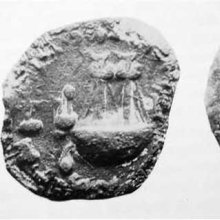Vasishthiputra, Vasiṣṭhiputra, Vaśiṣṭhiputra, Vashishthiputra: 1 definition
Introduction:
Vasishthiputra means something in the history of ancient India. If you want to know the exact meaning, history, etymology or English translation of this term then check out the descriptions on this page. Add your comment or reference to a book if you want to contribute to this summary article.
The Sanskrit terms Vasiṣṭhiputra and Vaśiṣṭhiputra can be transliterated into English as Vasisthiputra or Vasishthiputra or Vashishthiputra, using the IAST transliteration scheme (?).
Images (photo gallery)
India history and geography
Source: Shodhganga: Ajanta’s antiquityVasiṣṭhiputra (r. 130-158 CE) or Pulumāvi III is a king from the Sātavāhana dynasty of ancient India. The Sātavāhana lineage (known as Andhra in the Purāṇas) once ruled much of the Deccan region and several of the Ajantā caves at West-Khandesh (West-Khaṇḍeśa, modern Jalgaon) were carved in the 3rd century BCE when the region was ruled by kings (e.g., Vasiṣṭhiputra, also spelled Vaśiṣṭhiputra) and descendants of the Sātavāhana kings. Vasiṣṭhiputra was preceded by Gautamiputra Śātakarṇi and succeeded by Śivaśri (Śātakarṇi).

The history of India traces the identification of countries, villages, towns and other regions of India, as well as mythology, zoology, royal dynasties, rulers, tribes, local festivities and traditions and regional languages. Ancient India enjoyed religious freedom and encourages the path of Dharma, a concept common to Buddhism, Hinduism, and Jainism.
See also (Relevant definitions)
Full-text: Shivashri, Gautamiputra, Trirashmi, Pulumavi.
Relevant text
Search found 1 books and stories containing Vasishthiputra, Vashishthiputra, Vasiṣṭhiputra, Vaśiṣṭhiputra, Vasisthiputra; (plurals include: Vasishthiputras, Vashishthiputras, Vasiṣṭhiputras, Vaśiṣṭhiputras, Vasisthiputras). You can also click to the full overview containing English textual excerpts. Below are direct links for the most relevant articles:
A Historical Study of Kaushambi (by Nirja Sharma)
Kaushambi under the Maghas < [Chapter 2]
